Skin Rashes, Diseases and Conditions
A rash is an area of swollen, irritated skin that manifests in different patterns and varying shades of red, purple or brown. Some rashes are caused by allergic reactions to the environment, food or medications, while others appear because of a skin disorder or underlying disease or infection. Some clear up on their own, but others are chronic and require treatment to control symptoms.
What Are Skin Rashes?
Skin rashes develop when skin is irritated. They often appear as red, purple or brown patches and can also be dry and flaky, or dry and wet and oozy.
Rashes are a response of the skin to either an external or internal irritation. The causes range from allergic reactions to food or medication, to environmental exposure or as a result of chronic illnesses, autoimmune conditions or infection. Severe inflammatory conditions such as Stevens-Johnson Syndrome also cause rashes that cover over 50% of the skin’s surface.
Common Skin Rashes and Conditions
The most common rashes occur when skin comes in contact with an external trigger such as poison ivy or poison oak. Coming into contact with chemicals, such as a household cleaner, can cause a rash. Common allergens such as pet dander can also trigger rashes.
- Contact dermatitis
- Eczema (atopic dermatitis)
- Christmas tree rash (pityriasis rosea or herald rash)
Other types of rashes include hives (urticaria), which are caused by an allergic response. Conditions such as psoriasis and exposure to extreme heat also cause characteristic rashes.
It can be difficult to determine the cause of a rash. Always see a medical professional when something unusual appears on your skin.
Acne
Acne is a common skin condition that can result from excess oil and bacteria in clogged pores. Most blemishes are red and raised, but some have black or white heads in their center.
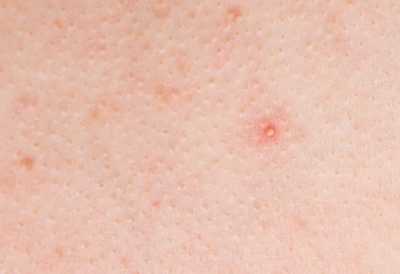
Acne affects all ages but is most prevalent in teenagers and young adults. Although acne often clears on its own, it sometimes needs over-the-counter topical treatments or prescription medications to control breakouts.
Hives (Urticaria)
Hives, or urticaria, appear as welts, bumps or plaques, called wheals. They’re itchy and either red or flesh colored. Hives are caused by an inflammatory response of the skin, which causes leakage from capillaries into the dermis. This results in puffiness, tenderness and other skin changes. Hives can appear anywhere on the body, and depending on the exposure, may change shape or expand.
Exposure to allergens such as antibiotics, pollen, pet dander, latex, bee stings and certain foods can cause hives. Stress and infections are other causes.
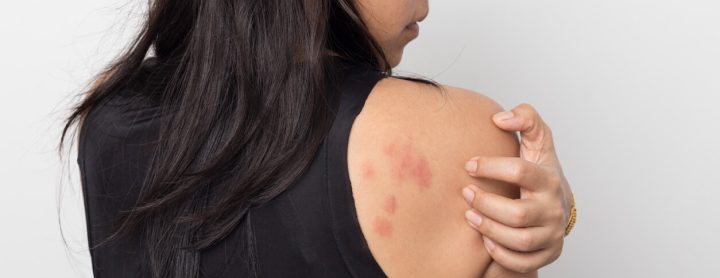
Most cases of hives go away after a few days. Some people have chronic hives that last for weeks or months. Hives can be treated with cold compresses, antihistamines, corticosteroids and anti-inflammatory medications such as prednisone.
You should see a medical professional if you notice changes in your skin. Hives can also be associated with other dangerous symptoms, such as difficulty breathing or chest pain. If you experience any of these, it may indicate a serious allergic reaction. If this is the case, seek emergency medical attention immediately.
Contact Dermatitis
Contact dermatitis is an itchy, red rash that forms when skin is irritated. Poison ivy, chemicals, soaps, sanitizers, certain metals and even sunlight are common causes. Some people develop bumps and blisters that can be filled with clear fluid.
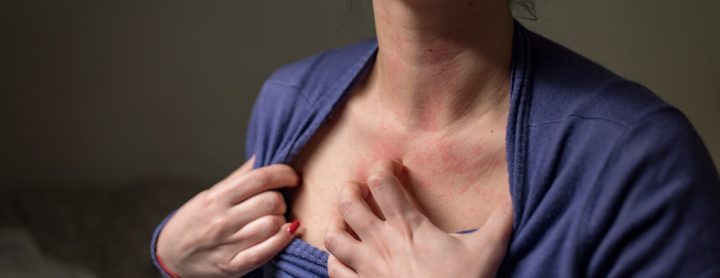
Contact dermatitis can occur hours or days after contact. Washing skin with soap and water may avoid triggering the condition. But keep in mind that rubbing the affected area with your hands may lead to spreading of the allergen, which can result in the rash spreading to other parts of the body that you may touch.
Eczema
According to the National Eczema Association, around 18 million American adults have eczema, also called atopic dermatitis, a chronic skin disease that typically first appears in childhood. An extremely itchy, flaky, red rash, usually on arms, legs and cheeks, characterizes this condition. Severe cases cause open sores.
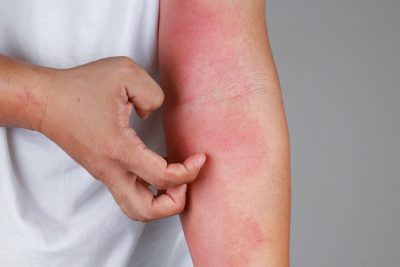
Breakouts of eczema come and go throughout the years. When a rash is active, it’s called a flare. People manage it with good skin care and by avoiding triggers. Some people use topical corticosteroids to control flares.
Psoriasis
Psoriasis is an autoimmune disease. Conditions such as psoriasis result because the body’s immune system begins to attack the skin. How the condition impacts the skin can vary, but it often manifests as a scaly, flaky, itchy rash that causes thick, raised patches of skin. These patches, called plaques, are light pink or deep red skin covered in a layer of dry, silvery skin called scales.
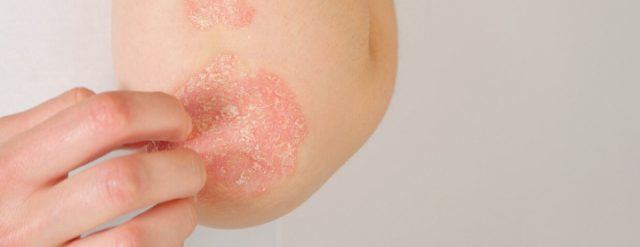
The condition typically affects the scalp, knees and elbows but can appear anywhere. It is also linked to other diseases like heart disease, diabetes and depression. Doctors treat the condition with prescription oral medications, topical ointments, topical drops and phototherapy.
Lupus
Lupus often presents as a distinctive butterfly-shaped rash across the nose and cheeks. An autoimmune disease, it causes the body’s immune system to attack healthy cells and tissues throughout the body. It occurs most frequently in women ages 15 to 44 and affects the entire body, including internal organs, joints and skin.
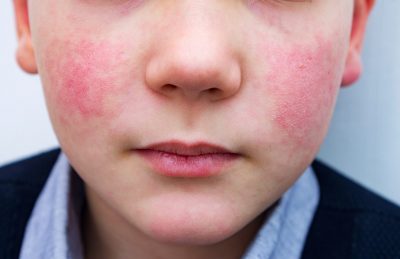
Doctors treat lupus with nonsteroidal anti-inflammatory drugs (NSAIDs), antimalarial drugs such as hydroxychloroquine, corticosteroids such as prednisone, and BLyS-specific inhibitors such as belimumab.
Heat Rash
Heat rash, sometimes called prickly heat, is a red, itchy rash made up of small prickly-feeling bumps that look like a cluster of pimples or blisters. It’s most common in children but can affect all ages.
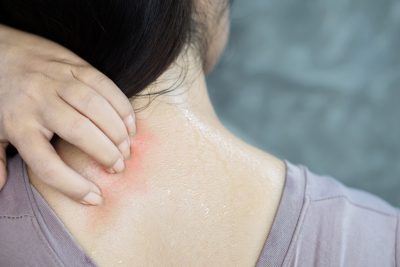
Hot, humid weather triggers heat rash, causing excessive sweat to get trapped in pores. It usually appears on the neck, groin, creases of the elbows and armpits and usually goes away after you spend time in a cool, dry place.
Disease and Infection-Related Skin Rashes
Some diseases and infections trigger a skin rash. Infections may be bacterial, viral or fungal.
Most disease-related rashes will clear up once the illness that caused them is treated. Some skin diseases may leave scars, especially if you scratch or pick them.
Shingles
Shingles manifests as an extremely painful rash with blisters that usually occur in stripes on one side of the body. Before a rash appears, the affected area will feel tender, itchy and tingly. Although the rash takes seven to 10 days to heal, associated pain can linger for months or years.
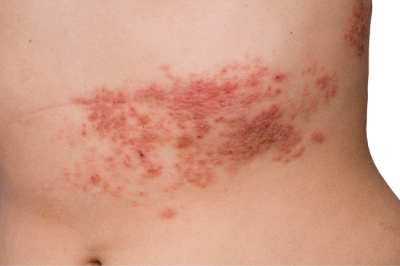
Shingles, also known as herpes zoster, is very common. Nearly 1 in 3 Americans develop shingles at some point. The varicella zoster virus, which also causes chicken pox, causes this condition. The Centers for Disease Control and Prevention recommends that people over 50 or those who have an autoimmune condition receive the Shinglex vaccine, which can lower your chance of getting the condition by 90%.
Chickenpox
Chickenpox presents as an itchy, body-wide rash that often has fluid-filled blisters that eventually scab over. It typically lasts four to seven days.

Chickenpox, like shingles, is the result of the varicella-zoster virus (VZV). If you’ve had chickenpox, you are at risk of developing shingles.
HIV
Because the immune system is compromised in HIV patients, an itchy, red rash can develop as a result of infection. It most commonly appears in either the early stages of infection or as a result of opportunistic infections. An adverse reaction to medication can also be a possible cause. Many antiretrovirals can cause mild to severe skin irritation. If you have HIV and notice any changes in your skin, contact your doctor as soon as possible.

Most of these rashes go away on their own within a few days or weeks, but some medication-induced rashes may point to a serious medication allergy. If you develop a rash, speak with your health care provider to determine the cause and best course of action.
Measles
People infected with the measles virus develop a red, spotty rash about three to five days into their illness. It usually begins on the face and spreads down to the feet. Once the measles go away, skin on affected areas may peel off.
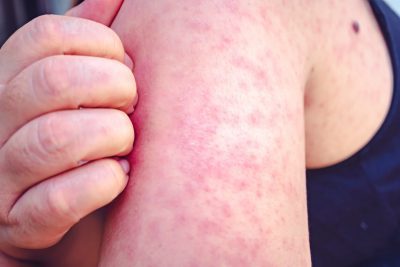
Prior to the rash stage of measles, about two to three days following the onset of symptoms, patients develop what are known as Koplik spots. These are tiny white dots that can appear in the mouth.
Measles has become more common in recent years due to falling vaccination rates. The best way to protect you and your family from this disease is to get the measles, mumps and rubella (MMR) vaccine.
Syphilis
In the primary stage of syphilis, a bacterial infection and sexually transmitted disease, an ulcer (chancre) typically develops at the site of transmission. These sores are generally painless and usually develop around the genitals, anus or mouth.
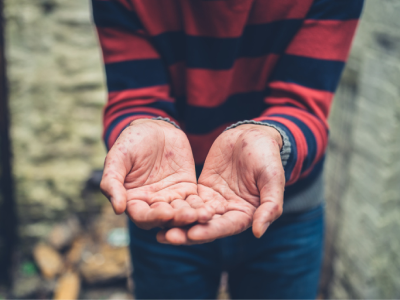
A rash is characteristic of the secondary stage, when syphilis can trigger a rash and swollen lymph nodes. Some patients also develop mucous patches within the mouth. Syphilis is treatable with antibiotics, but if left untreated, benign tumors and severe lesions can develop, as well as internal organ damage.
If you have recently engaged in unprotected sexual intercourse and notice any changes in your skin, contact your doctor.
Roseola
Roseola rashes begin as light red raised spots on the trunk. These spots turn white when touched. Over time, the rash may spread to other areas, including the face, neck, arms and legs.
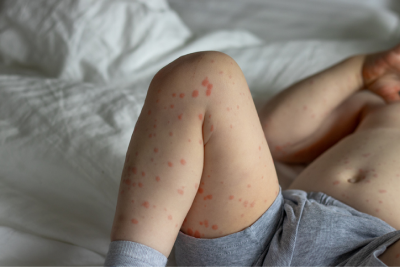
Two strains of the herpes virus can cause roseola. It typically affects children between 6 months of age and 2 years. Children with roseola first develop a high fever, then break out in a rash as the fever subsides.
Lyme Disease
The classic sign of Lyme disease is a bull’s-eye rash called erythema migrans. This rash is rarely itchy and can spread up to 12 inches across.
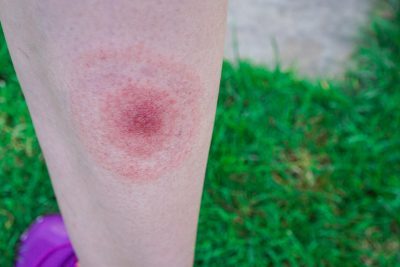
Lyme disease is a bacterial infection from the bite of an infected tick. Erythema migrans affects 70% to 80% of people with Lyme disease. It can take up to 30 days to appear after an infected tick bite.
Skin Rashes Caused by Medications
Skin rashes are a common side effect of medications. Some are minor reactions that disappear in a few days without treatment, but others can be life-threatening.
Contact your health care provider if you experience a rash or any other reactions while taking medication. Follow your doctor’s instructions. Stopping some medications abruptly can cause adverse effects.
Amoxicillin Rash
Nonallergenic rashes are a common side effect of the antibiotic amoxicillin. This is especially common among people taking the medication for the first time. The rash appears as slightly raised pink bumps on the trunk and may eventually spread to the legs, arms and face. It usually clears within three days.
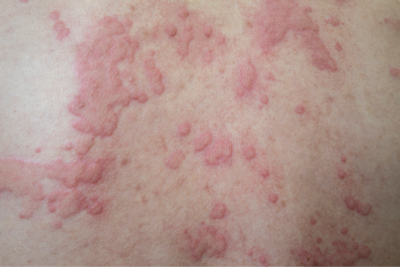
Allergic amoxicillin rash is more dangerous and starts within two hours of the first dose. It’s usually itchy and patients may also experience breathing problems.
Stevens-Johnson Syndrome (SJS)
Stevens-Johnson Syndrome (SJS) is a rare condition that begins with a fever and flu-like symptoms, then a raw, blistering, peeling rash that looks like a severe burn can develop. This rash starts on the chest and face, then spreads to other parts of the body.
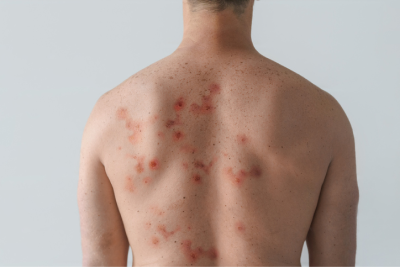
SJS can also cause difficulty breathing and swallowing. It’s a severe, potentially fatal reaction to certain medications. It requires emergency medical treatment and often results in hospitalization.
Erythema Multiforme Major (EMM)
Erythema multiforme major is a type of erythema skin rash that occurs in response to medication. It is similar to SJS. Like SJS, EMM requires emergency medical treatment and may be fatal.
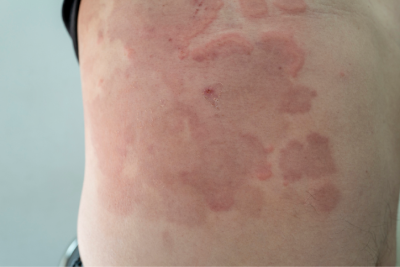
EMM rashes appear as red itchy spots all over the body with larger sores around the mouth, lips and genitals. These spots may resemble a bull’s-eye with a red ring around a red center.
Skin Disorders
Some skin disorders can look like rashes, though not all do. These conditions usually don’t have the typical symptoms of other rashes.
Additionally, skin disorders may not clear up with treatment. Sometimes blemishes associated with various disorders are permanent.
Vitiligo
Vitiligo is an autoimmune condition caused when the body’s immune system reacts to the pigment-producing melanocytes in the skin. It causes skin to lose its pigmentation, or color. Milky-white patches of skin appear on the face, arms, hands and feet. People with vitiligo may develop white hair on their head, in their beard, eyelashes and eyebrows.
People might confuse discolored skin patches with rashes, but vitiligo patches don’t inflame or itch. Sometimes vitiligo patches can improve in one area and then worsen in others. The condition can run in families, but there may be many variables at play in its cause.
Rosacea
Rosacea is a long-term, benign condition with four types, and people frequently experience symptoms from multiple types. With erythematotelangiectatic rosacea, enlarged blood vessels make the face appear red. Papulopustular rosacea is known for whiteheads. Phymatous rosacea is rare and can cause skin thickening and scarring. Ocular rosacea impacts the eyes.
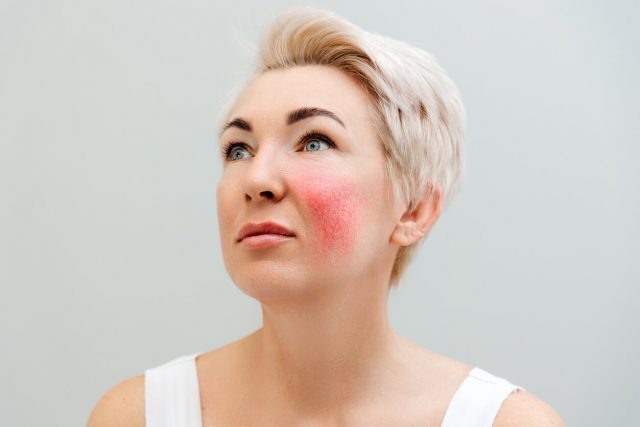
While there is no cure for rosacea, symptoms can be managed. Avoiding allergens and other triggers can help, as can wearing sunscreen and avoiding foods that dilate blood vessels such as alcohol and nitrate-rich foods, including processed and packaged meats. Your doctor may also prescribe oral or topical antibiotics and other prescription creams.
When to Seek Treatment for a Rash
Most rashes are not life-threatening, but some symptoms may point to a more serious problem.
- A rash appears suddenly and spreads rapidly.
- It covers your body.
- It is painful.
- You have signs of infection, including swelling, crusting, oozing yellow or green fluid or a red streak coming from the rash.
- You also have a fever.
- Blisters in the rash turn into open sores.
Call your doctor as soon as possible if you notice any of these signs. Some rashes are early indicators of urgent problems.
Home Remedies for Skin Rashes
You can treat simple rashes at home with over-the-counter remedies, such as zinc oxide ointment, calamine lotion and oral antihistamines to control itching and other symptoms. Hydrocortisone creams help adults but aren’t for children. But it’s always best to discuss home treatments with your health care provider to avoid potential drug interactions or adverse reactions to ingredients.
Calling this number connects you with a Drugwatch.com representative. We will direct you to one of our trusted legal partners for a free case review.
Drugwatch.com's trusted legal partners support the organization's mission to keep people safe from dangerous drugs and medical devices. For more information, visit our partners page.

